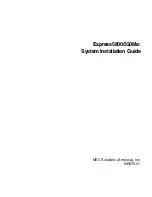
Programming 66
3.7 Example of Network Interrupt Handling
The
following
is
an
example
of
the
steps
necessary
to
set
up
the
RFM
‐
5565
to
generate
a
PCI
interrupt
in
response
to
one
of
the
four
basic
network
interrupts.
This
example
also
lists
the
steps
necessary
to
service
that
interrupt.
When
using
this
example,
it
is
advisable
to
examine
and
to
obtain
a
visual
sense
of
the
circuitry
involved.
3.7.1 Setup
1.
Clear
any
prior
unscheduled
interrupts
in
the
SID1
FIFO
by
writing
zero
(0)
to
the
SID1
at
PCIBAR2
+
offset
$24.
2.
Clear
any
prior
unscheduled
interrupts
in
the
SID2
FIFO
by
writing
zero
(0)
to
the
SID2
at
PCIBAR2
+
offset
$2C.
3.
Clear
any
prior
unscheduled
interrupts
in
the
SID3
FIFO
by
writing
zero
(0)
to
the
SID3
at
PCIBAR2
+
offset
$34.
4.
Clear
any
prior
unscheduled
interrupts
in
the
SID4
FIFO
by
writing
zero
(0)
to
the
SID4
at
PCIBAR2
+
offset
$3C.
5.
Using
a
read
‐
modify
‐
write
operation,
set
Bit
07,
Bit
02,
Bit
01
and
Bit
00
high
(1)
in
the
LIER
register
at
PCIBAR2
+
offset
$14.
This
allows
any
one
of
the
four
basic
network
interrupts
to
assert
the
onboard
signal
LINTi#,
provided
the
global
enable
in
the
LISR
is
also
high
(1).
6.
Write
the
value
$4000
to
the
LISR
register
at
PCIBAR2
+
offset
$10.
The
value
$4000
sets
the
Global
Interrupt
Enable
(Bit
14)
high
(1)
and
clears
any
unre
‐
lated
sources.
You
may
prefer
to
use
a
read
‐
modify
‐
write
operation
if
other
sources
in
the
LISR
are
to
remain
unchanged.
7.
Using
a
read
‐
modify
‐
write
operation,
set
Bit
8
and
Bit
11
high
(1)
in
the
INTCSR
register
at
PCIBAR0
+
offset
$68.
Bit
8
is
the
PCI
Interrupt
Enable
and
Bit
11
is
the
Local
Interrupt
Input
(LINTi#)
Enable.
3.7.2 Servicing Network Interrupts
Read
the
INTCSR
register
at
PCIBAR0
+
offset
$68.
Verify
that
the
Local
Interrupt
Input
Active
(Bit
15)
is
high
(1).
If
Bit
15
is
not
high,
or
if
another
interrupt
source
within
the
INTCSR
has
priority,
then
the
user’s
interrupt
service
routine
would
take
different
steps
from
this
point
on.
Read
the
LISR
register
at
PCIBAR2
+
offset
$10.
Determine
if
the
Pending
Network
Interrupt
4
(Bit
07),
the
Pending
Network
Interrupt
3
(Bit
02),
the
Pending
Network
Interrupt
2
(Bit
01),
or
the
Pending
Network
Interrupt
1
(Bit
00)
is
high
(1).
Assuming,
for
example,
the
previous
step
indicates
Network
Interrupt
2
is
pending,
read
the
Interrupt
2
Sender
Data
FIFO
at
PCIBAR2
+
offset
$28
and
place
the
value
in
the
desired
user
location.
If
the
user
is
not
passing
data
with
the
interrupt,
then
this
step
is
unnecessary
and
may
be
skipped.
Read
the
Interrupt
2
Sender
ID
FIFO
at
PCIBAR2
+
offset
$2C
and
place
the
value
in
the
desired
user
location.
This
value
is
the
node
ID
of
the
source
of
the
network
interrupt.
Provided
that
there
are
no
additional
network
interrupts
stored
in
the
Sender
ID
FIFO,
the
act
of
reading
this
value
will
de
‐
assert
the
Pending
Network
Interrupt
2
bit
(Bit
01)
in
the
LISR,
which
in
turn
de
‐
asserts
the
LINTi#
line.
De
‐
asserting
the
LINTi#
line
will
de
‐
assert
the
PCI
interrupt.





































